
2.2 Bionics in buildings of Gaudí
Building Bionic has become a new trend of the times, but also architectural culture of the new topics. A reasonable construction in order to inspire innovation, and to enable the urban environment to achieve ecological balance and sustainable development, architectural bionics is an important means. Architecture bionics is based on the natural environment and social and ecological laws, combined with architectural characteristics of science and technology for integrated applications of science.

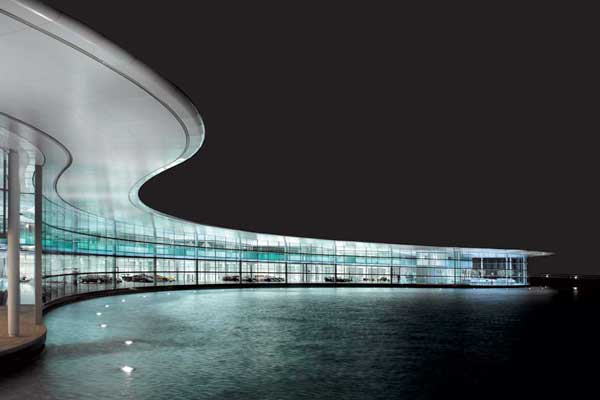
Norman Foster. McLaren Technology Centre.
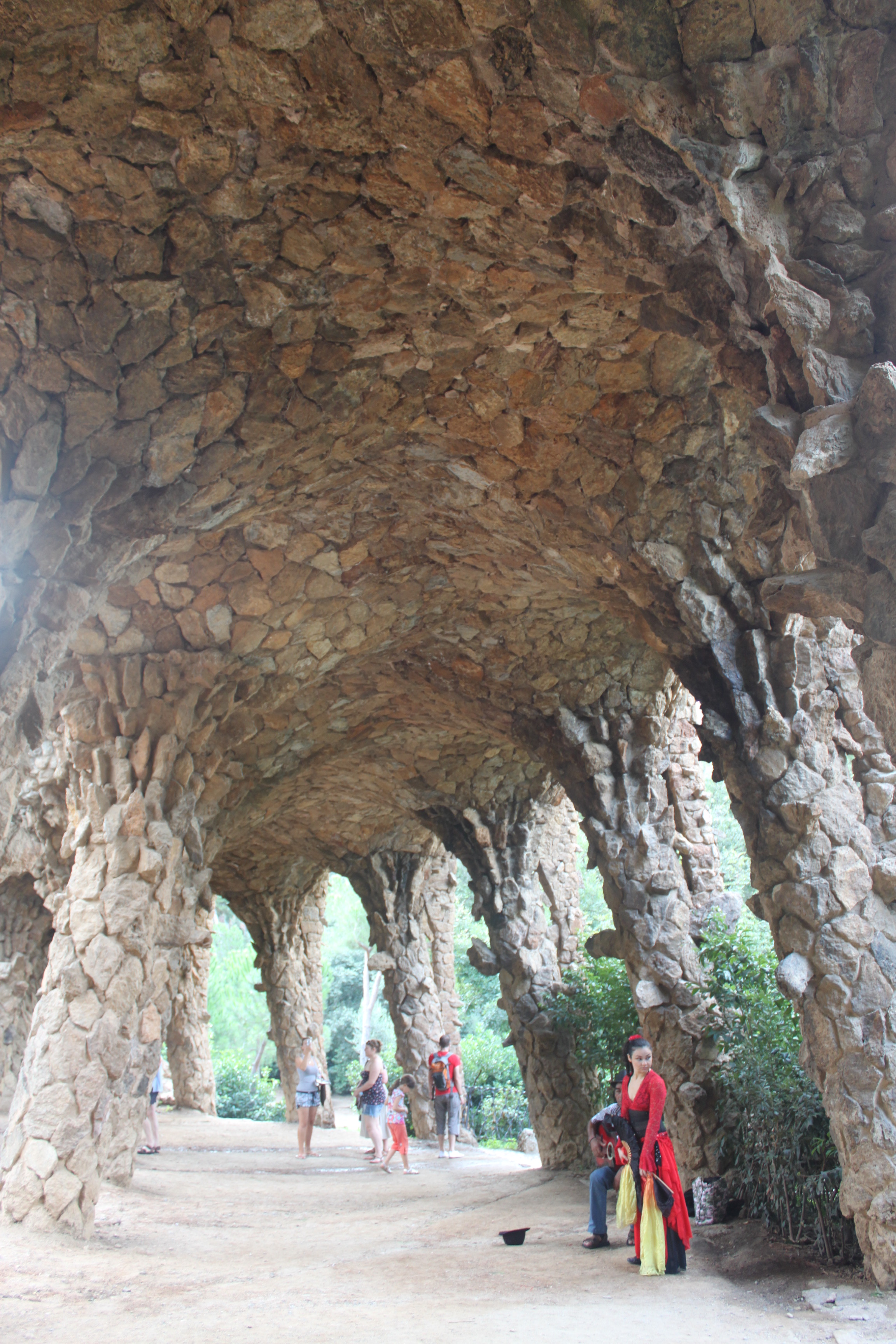
Norman Foster
This projects of Antony Gaudí and
Norman Foster reflect one of the natural feature:
parabolic constructions.
Antony Gaudí. Park Güell
Bionic architectural forms are most common, it not only can obtain new shape, but often can play a role in the new structural system to create extraordinary results. The first application of bionic form of modern Spanish architect is Gaudi (Antonio Gaudi), Barcelona, he designed a number of animal bones with a clear form of apartment buildings, this metaphor of the dragon to overcome the ancient coastal city of legends. Such as the 1904-1906 year built Casa Batllo and Mila apartment built in 1910 was like that.
Gaudí studied organic and anarchic geometric forms of nature thoroughly, searching for a way to give expression to these forms in architecture. Some of his greatest inspirations came from visits to the mountain of Montserrat, the caves of Mallorca, the saltpetre caves in Collbató, the crag of Fra Guerau in the Prades Mountains behind Reus, the Pareis mountain in the north of Mallorca and Sant Miquel del Fai in Bigues i Riells.
Study of nature translated into his use of ruled geometrical forms such as the hyperbolic paraboloid, catenoid, the hyperboloid, the helicoid and the cone.
All this forms can be found in the nature. The shells of snails and seashells have helicoid forms. Plants have ellipsoid and hyperbolic structure.

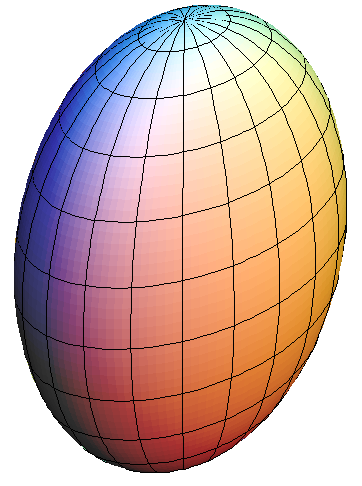







hyperbolic paraboloid
Helicoid construction
Park Güell
In 1900 Antoni Gaudí and his generous patron, Eusebi Güell, drew up the impressive plans for the perk located on the outskirts of Barcelona: a garden city designed for future inhabitants with a great deal of disposable income to live far away from the hustle and bustle of the city.
Gaudí was a great nature lover and wanted to make sure that the constructions within the complex blended in with heir natural surroundings.
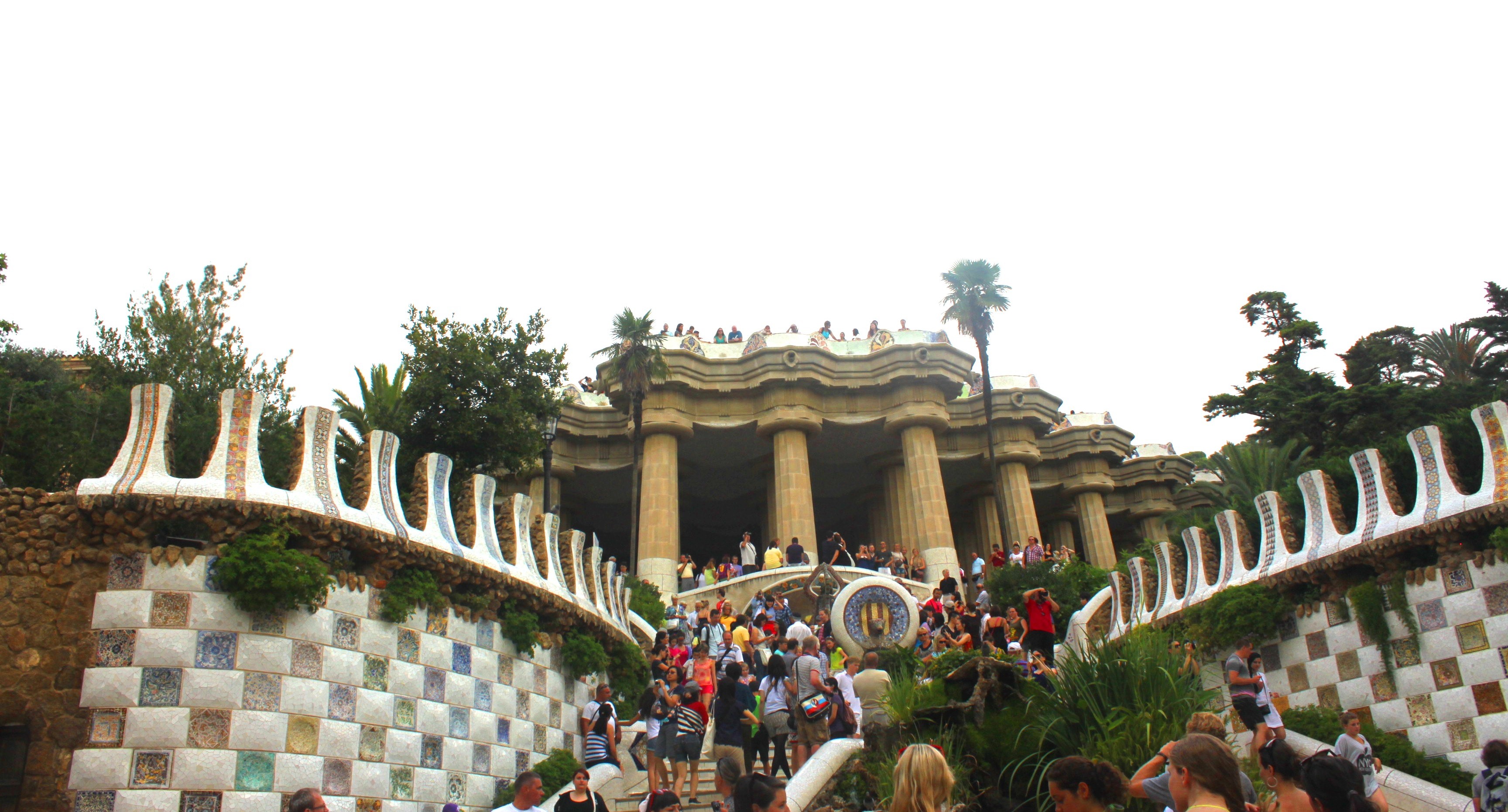
Park Güell
At the end of the 19th century, large areas on the outskirts of London were being developed for residential housing, a new lifestyle approach that so impressed Eusebi Güell that he purchased 17 hectares of land in 1899 with the aim of carrying out a similar project. In order to make this utopian dream a reality, Güell wasted no time in asking his friend Antoni Gaudí to design the park, who agreed in the realization that this project would offer him the opportunity to apply his knowledge of construction and engineering.
Many famous constructions are located in the Park Güell, but the most impressive are the two original lodges flanking the main entrance, the entrance stairway, the hypostyle hall, the large square enclosed by a bench that snakes its way around the edge, the aqueducts surrounding the park, and the show-houses.
In this great project Gaudí used widely organic elements. This park reflects natural forms and natural surrounding. The main stairway as if grows from the earth and a design resembles the wave.


The main stairway
Model of the entrance stairway, Museum of Gaudí, Reus, Spain
Inclined columns designed in the cateniod construction:


Another element widely used by Gaudí was the catenary curve. He had studied geometry thoroughly when he was young, studying numerous articles about engineering, a field that praised the virtues of the catenary curve as a mechanical element, one which at that time, however, was used only in the construction suspension bridges. Gaudí was the first to use this element in common architecture.
Gaudi used various catenaries in the park. Due to the angle of the arches, this hall of columns creates an amazing illusion:
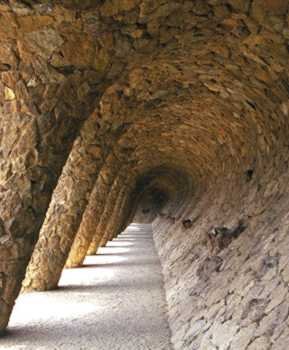

Park Güell
Gaudí found abundant examples of them in nature, for instance in rushes, reeds and bones; he used to say that there is no better structure than the trunk of a tree or a human skeleton. These forms are at the same time functional and aesthetic, and Gaudí discovered how to adapt the language of nature to the structural forms of architecture. He used to equate the helicoid form to movement and the hyperboloid to light. Concerning ruled surfaces, he said:
“Paraboloids, hyperboloids and helicoids, constantly varying the incidence of the light, are rich in matrices themselves, which make ornamentation and even modelling unnecessary”.
He designed a number of animal bones with a clear form of apartment buildings.
The nature has stiffened in a stone.
The focal point of the park is the main terrace, surrounded by a long bench in the form of a sea serpent. This bench has a sinusoidal structure. To design the curvature of the bench surface Gaudí used the shape of buttocks left by a naked workman sitting in wet clay. The curves of the serpent bench form a number of enclaves, creating a more social atmosphere.

The main bench
Casa Batlló
It has a visceral, skeletal organic quality. The building looks very remarkable. The ground floor, in particular, is rather astonishing with tracery, irregular oval windows and flowing sculpted stone work.
In this refurbishment on of an existing building, the colorful façade, the inner courtyard, the roof terrace and the main floor for which Gaudí designed all the furnishings are particularly notable. Here we find undulating organic shapes, centenary arches, wrought ironwork and trencadis. The construction of balcony has cockleshell form.

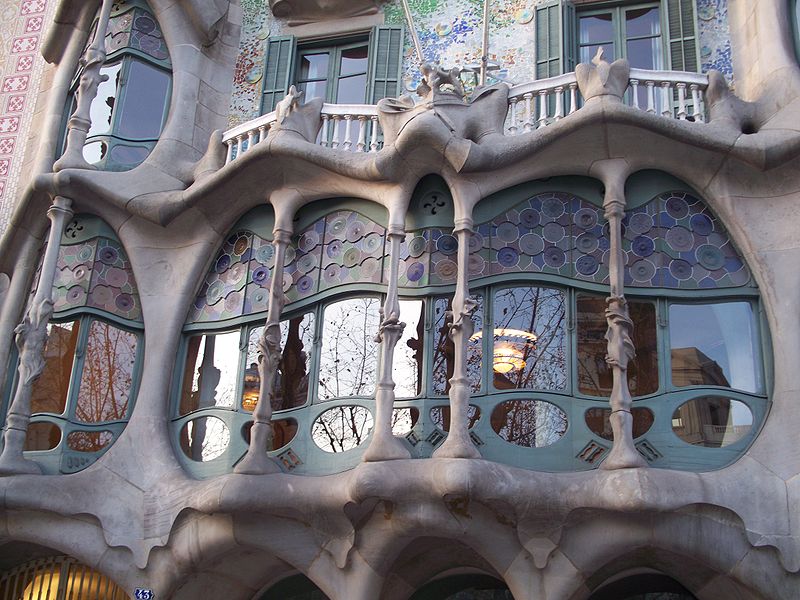
Casa Batlló
Casa Batlló, balcony
Architect also used catenary curves in this project.
Catenary arches in works like the Casa Batlló, Casa Milà, the School of the Teresianas, the crypt of the Colònia Güell and the Sagrada Família allowed Gaudí to add an element of great strength to his structures, given that the catenary distributes the weight it regularly carries evenly, being affected only by self-canceling tangential forces.
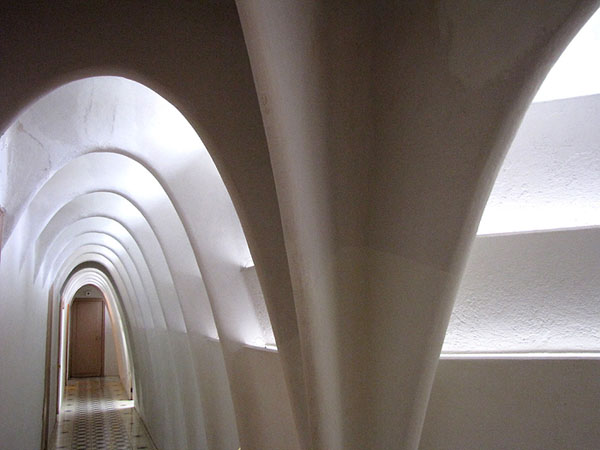

Catenary
Catenary
arches in the School of the Teresianas
Sagrada Familia
Gaudí conceived this church as if it were the structure of a forest, with a set of tree-like columns divided into various branches to support a structure of intertwined hyperboloid vaults. He inclined the columns so they could better resist the perpendicular pressures on their section. He also gave them a double turn helicoid shape (right turn and left turn), as in the branches and trunks of trees. This created a structure that is now known as fractal. Together with a modulation of the space that divides it into small, independent and self-supporting modules, it creates a structure that perfectly supports the mechanical traction forces without need for buttresses

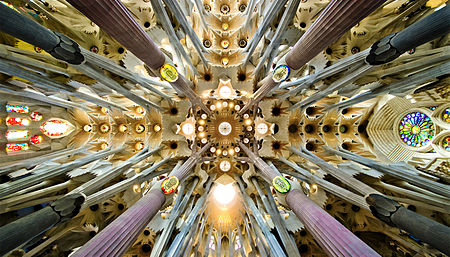
The nave in the Sagrada Familia with a hyperboloid vault.
Inspiration from nature is taken from a tree, as the pillar
and branches symbolise trees rising up to the roof.
Gaudí conceived the atmosphere of the interior of the church as a leafy wood.
The columns divide into different branches, and the same law that serves to design the trunk, with a double twist, from the star to the circle, will serve for the branches to return from the circle to the star or the polygons, and as many times as necessary according to the different levels of superimposition of branches in each case.
For example, the column of the upper part of the choir in the side nave presents a straight line in the upper section which, as the column descends, is transformed into a rhomboid, a square, an octagon, polygons with 16 and 32 sides and the circle. The four upper columns begin in the square that is transformed as the column rises into the octagon, the polygon with 16 sides, the polygon with 32 sides and the circle.

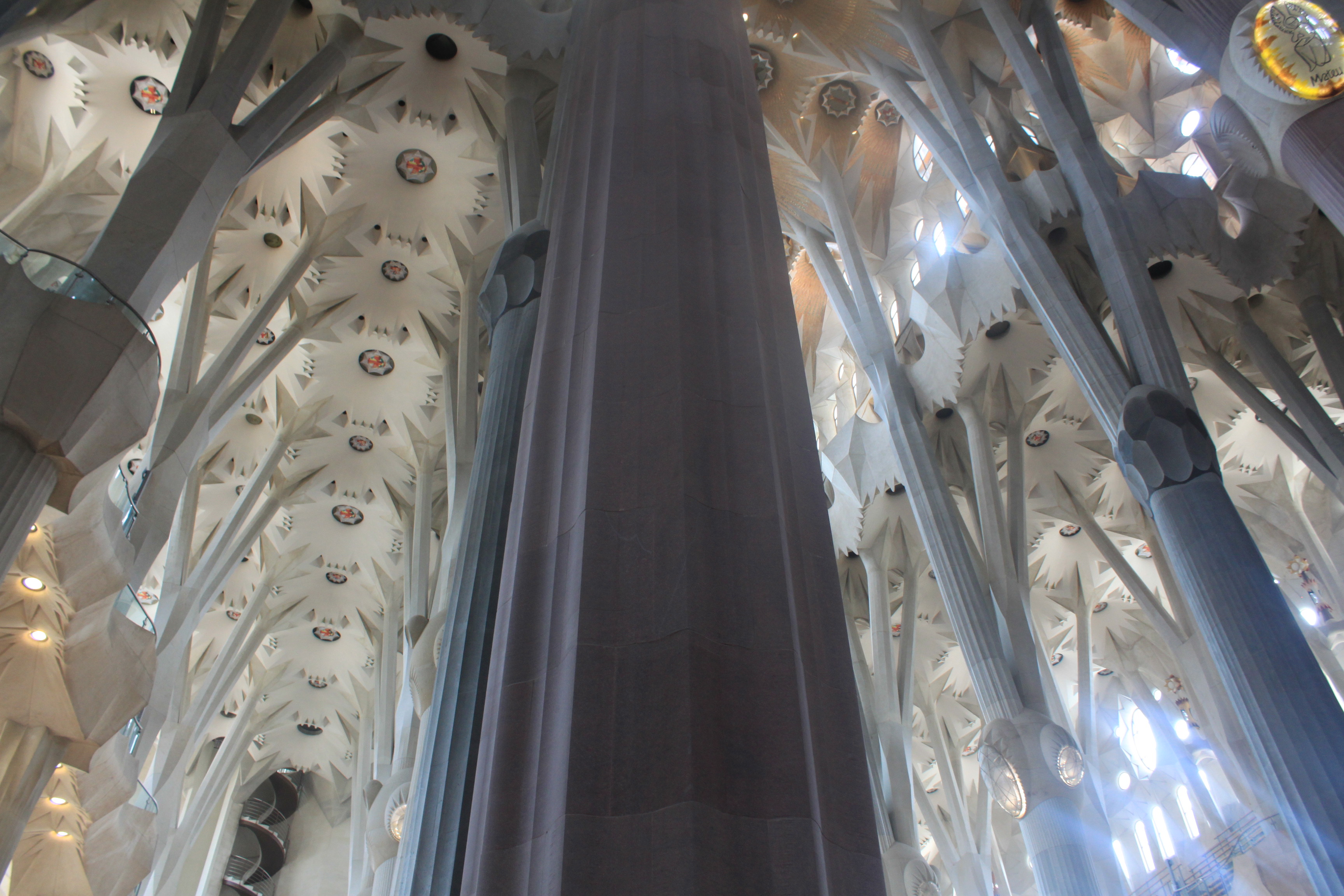
Antoni Gaudi invented a new column in the history of architecture: the double twisted column.
The double twisted column begins at the base with a regular or starred polygon with straight or parabolic sides or with a combination of polygons which, as the column rises, are transformed into different sections with an increasing number of vertices, until they reach the circle at the top.
Geometrically it is the intersection of two helicoidal columns with the same base, but with opposite twists. All the branching columns are double twisted, but with different polygons at the base. With this type of column Gaudí achieves the continuity of arrises and surfaces between one column and the ones above or beneath it.
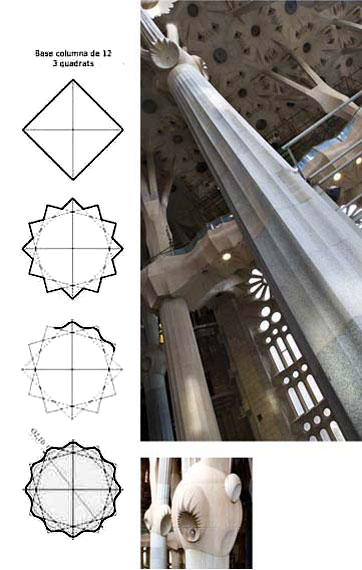

The columns of the crossing are made from a 12 pointed star. Those of the evangelists, from a 10 pointed star. Those of the nave and those of the apse, from an 8 pointed star. And those of the side naves and choir from a 6 pointed star. In all cases the stars have their interior and exterior points rounded with tangent parabolic arches, which, in the first stretch of the column, obtains a smooth undulation of the surface which cries out to be touched.
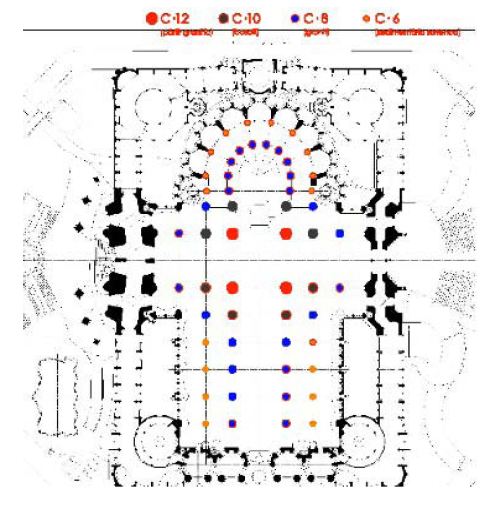
Details of the columns, which designed in ellipsoid structure, have form of flower's buds.

Ellipsoid
According to Gaudí’s own symbology, the hyperboloid represents light and that is why he used it, particularly on all the points the light has to pass through to be diffused and transmitted from one part to another, from an exterior to an interior.
And so we can find hyperboloids on the windows, circular or elliptical hyperboloids, the latter easily identifiable from the elliptical rose window.
On the vaults and windows, the hyperboloid is bounded by star shapes created by the straight lines. The vaults and the windows are intersections between hyperboloids, linked with paraboloids thanks to straight lines that are common to two surfaces.
We can find hyperboloids on the capitals of the columns. When
the columns reach the vaults with the circular section we find the figure of the hyperboloid, the best solution because it is a natural extension of the circle, necessary for generating the funnel that collects the loads.




Hyperboloid
Thus Gaudí achieves the continuity that so often exists in nature.
Gaudí also used catenary curves in the structure of the project For catenary designs, Gaudi developed the hanging-chain funicular model in depth for his project. Gaudi constructed these models over a mirror so he could visualize the actual building as he worked. This method exploits the property of a catenary curve, which describes a chain in pure tension. When the catenary is inverted it becomes a curve in pure compression.
Gaudí always chose the simplest path when it came to making the calculations for his projects. At that time, with no calculators or computers, a good graphic calculation was more efficient that a pile of papers of calculations with analytical operations. But that was the most trodden path. Gaudí distanced himself from his contemporaries’ way of doing things and went beyond that phase of the graphic calculation and on to empirical experiments with hanging models with weights and strings, a system which no other architect in the world had ever developed to the degree and on the scale which he did.
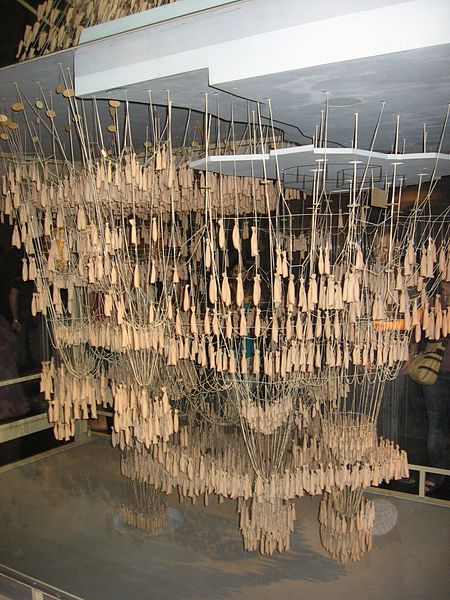
Hanging model displaying catenary curves of
the Sagrada Familia
